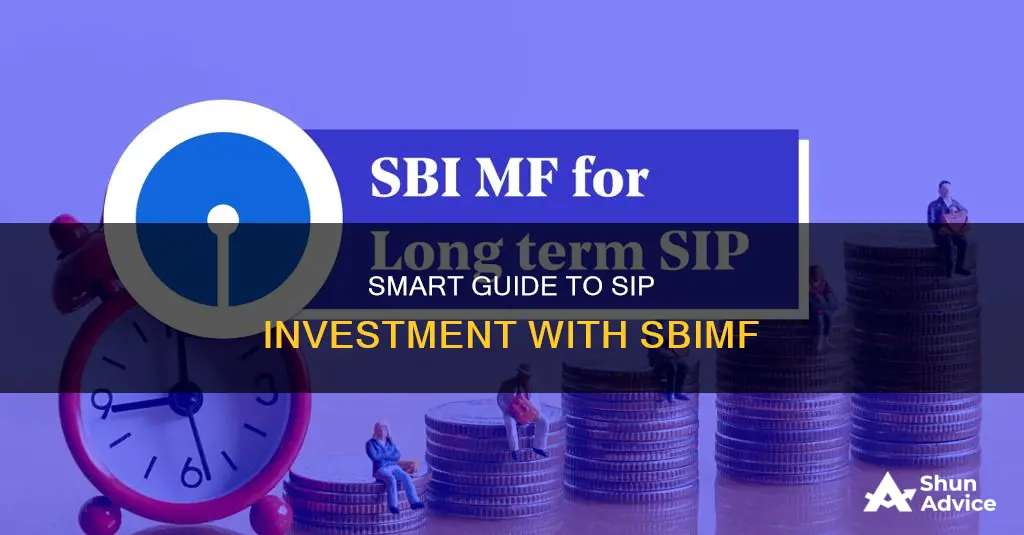
Investing in a Systematic Investment Plan (SIP) is a great way to build wealth over time. SIPs allow investors to invest a fixed amount of money at regular intervals, such as monthly or quarterly, into different types of mutual funds. This approach minimises the risk of loss and helps investors purchase mutual fund units at lower costs.
To invest in an SIP using SBI Mutual Fund, you can follow these steps:
1. Determine your investment objectives and choose a scheme that aligns with your risk appetite and investment horizon.
2. Ensure you are KYC compliant by submitting the necessary documents, such as proof of address and identity (PAN card, Aadhaar, etc.).
3. Choose the date and duration of your SIP.
4. Decide on the amount you want to invest and set up the frequency of your SIP based on your cash flow.
5. Start your SIP by submitting the form online or offline.
You can invest in an SIP through the SBI Mutual Fund website, a distributor, or a platform like ET Money. It is important to consider your financial goals, investment horizon, and risk appetite before investing.
| Characteristics | Values |
|---|---|
| Minimum Investment Amount | Rs. 500 per month (Rs. 1,000 for SBI Small Cap Fund) |
| Investment Frequency | Weekly, monthly, quarterly, semi-annually, annually |
| Investment Duration | Minimum of 3 years, no maximum tenure |
| Investment Types | Equity, debt, and hybrid mutual funds |
| Investment Methods | Online (through the SBI Mutual Fund website or ET Money platform), offline (through a distributor or the ET Money app), or through the official website of the fund house |
| Required Documents | PAN Card, address proof, identity proof (passport, driving license, etc.), bank account details |
| KYC Procedure | Digital KYC through the SBI Mutual Fund online portal or offline through authorised banks or post offices |
What You'll Learn

How to register for a SIP
To register for a SIP account with SBI Mutual Fund, you can follow these steps:
Online:
- Determine your investment objectives and then, based on your risk appetite, choose a scheme according to your investment horizon.
- Make sure that you are KYC compliant.
- Choose the date and the duration of the SIP.
- Choose the amount you want to invest in the scheme, along with setting up the frequency of SIP based on your cash flow.
- Start the SIP by submitting the form online.
Offline:
- Procure the application and KYC form (if the KYC procedure has not been completed) from the website or any branch of SBI Mutual Fund or an empaneled distributor office.
- Fill out the application/KYC (if applicable) form, providing necessary information such as name, address, PAN, email address, and mobile number. This email address and mobile number will be used for further communication and can also be used to register for online transaction services.
- Attach copies of relevant documents and submit them along with a cheque or demand draft of the desired investment amount.
- Submit the duly signed application/KYC (if applicable) form(s), with the cheque and all relevant documents, to any branch of SBI Mutual Fund or point of acceptance.
- SBI Mutual Fund will then allocate and provide you with a folio number for that particular investment. You will also receive an Account Statement after the transaction is processed.
Smart Strategies to Invest Cash for High Yield Returns
You may want to see also

The benefits of using a SIP calculator
A Systematic Investment Plan (SIP) is a facility offered by mutual funds that allows investors to invest a fixed amount of money at pre-defined intervals. The benefits of using a SIP calculator are:
- Up-to-date investment options: SIP calculators consider real-time stock values and provide projected growth estimates based on past performance. This ensures that you have access to the most current investment opportunities.
- Efficient utilisation of compounding: SIP calculators help you identify the best investment products with a history of assured growth, taking into account company background and research. This helps you avoid market fluctuations due to company-related factors.
- Lower investment amounts: SIP calculators can accommodate lower investment amounts, allowing you to start investing even with limited funds. You can set a lower limit to find investment products within your budget.
- Personalised schemes: By inputting your personal details, SIP calculators generate personalised results. This means you get investment plans tailored to your financial capabilities and lifestyle choices.
- Ease of use: SIP calculators are easy to use and provide instant results. You only need to input a few details, and the calculator will handle the rest, making it accessible even for first-time investors.
- Free and online availability: SIP calculators are free of cost and readily accessible online, allowing you to perform calculations from anywhere.
Journaling a Large Cash Investment: A Step-by-Step Guide
You may want to see also

The documents required to invest in an SBI Mutual Fund
To invest in an SBI Mutual Fund, you must complete a few steps, which include determining your investment objectives, ensuring you are KYC compliant, choosing the date and duration of the Systematic Investment Plan (SIP), and the amount you want to invest. You will also need to submit specific documents, which are outlined below:
Documents Required for SBI Mutual Fund Investment:
- Application Form: You need to fill out an application form, providing necessary information such as your name, address, PAN (Permanent Account Number), email address, and mobile number. This application form can be procured from the SBI Mutual Fund website or any branch of SBI Mutual Fund or an empaneled distributor office.
- Know Your Customer (KYC) Form: The KYC form is required if you have not completed the KYC procedure. You can obtain this form from the same sources as the application form.
- Relevant Documents: Attach copies of relevant documents, but the specific documents are not mentioned.
- Payment: Along with the duly signed forms, you must submit a cheque or demand draft for the desired investment amount.
Once you have completed and submitted the forms with the necessary documents and payment, SBI Mutual Fund will provide you with a folio number for your investment. You will also receive an Account Statement after the transaction is processed.
Cash App Investing: Why You Can't Invest on the Platform
You may want to see also

The different types of SIPs available
Fixed SIP (Regular SIP)
The most simple and popular type of SIP. Investors can contribute a fixed amount at specific regular intervals for a desired investment term period. The frequency of SIP can be set either weekly, monthly, quarterly or annually as per the investor’s convenience.
Flexible SIP
A flexible SIP is similar to a regular SIP but allows investors the opportunity to increase or decrease the investment amount as per their financial situation. The regular contribution of the investor can be adjusted according to the cash flow. Sometimes, some fund houses even give an option to change the intervals as per the financial crunch.
Perpetual SIP
In a perpetual SIP, an investor does not set a time period and regularly contributes until they decide to stop or modify. Initially, one could do it indefinitely, but recently, from October 2023, the National Automated Clearing House (NACH) has introduced a maximum term of 30 years for setting up SIP from the start date.
Trigger SIP
A trigger SIP option allows investors to set triggers depending on when a specific event occurs in the market. It can be a pre-defined trigger prompting when the market suddenly dips or has a favourable condition, a specific index level, or even a net asset value of the units. An investor can start, redeem units or switch to another plan based on these triggers. It is suitable for investors who understand the dynamic nature of the market as it is based on speculations.
Step-up SIP (Top-up SIP)
A Step-up SIP provides investors with the facility to gradually increase their SIP instalment amount at a pre-determined rate at intervals. One can begin SIP with a fixed amount and opt for a regular top-up. It is good for people expecting annual increments or receiving bonuses. An investor can gradually increase the recurring contributions to the SIP with increased cash flow, which will help accumulate a wealth corpus.
Value Averaging Investment Plan (VIP)
A Value Averaging Investment Plan is similar to a conventional SIP, where an investor makes higher investments when the market dips to buy more units. Though it buys more when the market is low, it may result in higher returns. However, investors would require a lot of liquid cash to enrol for a VIP as they will have to make extra investments whenever there is a significant market fall. This lack of predictability is one of the main reasons why many average investors do not opt for VIP, and it is usually suitable for HNIs.
Multiple SIP (Multi-Select SIP)
It is a unique SIP offering that allows investors to invest across multiple mutual funds from one fund house with a single SIP facility. With one SIP, an investor can diversify their investment portfolio as the money is automatically distributed into multiple schemes. It also reduces the paperwork for managing multiple SIPs together.
Investing Activities: Statement of Cash Flows Impact
You may want to see also

How to choose the right SIP plan
Systematic Investment Plans (SIPs) are a great way to save a little money regularly, so you have access to a larger capital resource later on. They are especially useful for salaried individuals, allowing them to accumulate a portion of their salaries into investment plans for later use.
Set long-term goals and tag SIPs to goals:
SIPs work best when they are designed around equity funds and are tied to long-term goals. You can have multiple SIPs tied to a single goal or a single SIP tied to multiple goals. This induces discipline in your SIP investment as you remain committed to your purpose.
Choose products based on your risk-return trade-off:
You can opt for SIPs on equity funds, debt funds, or liquid funds, depending on your goal, time horizon, and criticality. If you have a shorter tenure, liquid funds or liquid-plus funds are a better choice. SIPs on equity funds are ideal for long-term goals, such as beyond seven years, and should be structured on diversified equity funds or multi-cap funds.
Decide between a direct plan and a regular plan:
Direct plans do not include distribution and trail fees, resulting in higher returns. However, consider the extent of advisory support you need. If you opt for a direct plan, you may want to consult an independent advisor for guidance.
Understand that equity SIPs are for the long term:
Equity SIPs may not provide instant gratification. They work best over longer periods, allowing the power of compounding to work in your favour. A three-year equity SIP may not yield favourable results due to market cycles. The longer your SIP sustains, the more rupee-cost averaging works in your benefit, reducing the cost of acquisition and enhancing returns.
Make a conscious choice of funds for SIPs:
When selecting equity funds for your SIP, consider factors such as the pedigree and AUM (Assets Under Management) of the fund. Avoid funds with frequent changes in the fund management team, as this can lead to inconsistent investment philosophy. Focus on risk-adjusted returns and the consistency of returns rather than absolute returns.
Decide on a fixed SIP amount and stick to it:
Avoid the temptation to time the market by increasing or decreasing your SIP amount based on market corrections. Instead, let time work in your favour by keeping the amount fixed. This allows you to benefit from cost averaging and compounding returns.
Benchmark SIP performance:
Compare the performance of your SIP with index fund returns and peer group funds. This ensures that your SIP provides the benefits of active fund management and that your fund manager's decisions are aligned with market realities.
Additionally, when choosing a SIP plan, consider the following:
- Consult your bank's relationship manager to discuss mutual fund options and returns.
- Research online to browse performance records of SIPs and evaluate historical returns.
- Choose a mutual fund that has been in the market for at least five years.
- Opt for a fund operated by your bank, as it provides convenience and easier access to information.
- Select a reputable and recognizable "fund house" with a large asset size or corpus, indicating reliability and performance.
- Avoid plans with high-risk factors, such as volatility and low liquidity.
- Consider ELSS (Equity Linked Savings Scheme) tax saver plans, which offer tax benefits and help accumulate a larger corpus.
- Look for funds with good rankings accredited by CRISIL-rated funds (rankings 1-3 are ideal).
Remember, the right SIP amount is the one that helps you reach your financial goals. Ensure that you periodically review and rebalance your portfolio as needed.
Cash App Investing: How to Stop and Withdraw
You may want to see also
Frequently asked questions
Systematic Investment Plan (SIP) allows you to invest a fixed amount at regular intervals in a scheme, taking advantage of the power of compounding. This means you earn interest on your interest as it is added to the original amount, which is beneficial for long-term wealth creation.
A Systematic Investment Plan (SIP) is an investment tool that allows investors to invest a fixed amount at regular intervals in a Mutual Fund scheme. SIP works by investing a fixed amount at a defined frequency, eliminating the need to time the market.
The minimum amount to invest in SIP may differ depending on the scheme. Contact your financial advisor or refer to the SBIMF website for more information.
To renew your SIP, fill out a new form, start a new SIP, and choose the desired duration.
Yes, you can start a new SIP and choose the desired duration by filling out a new SIP enrollment form or through the online platform, Investap.







